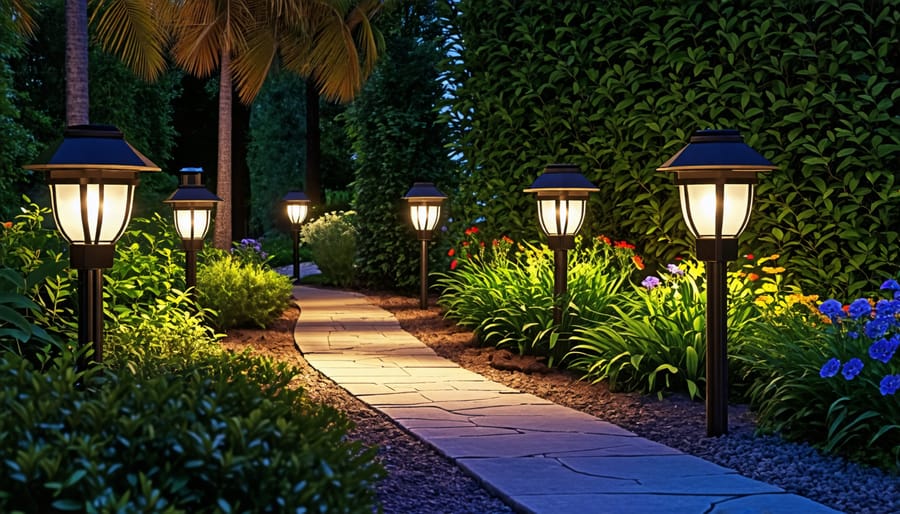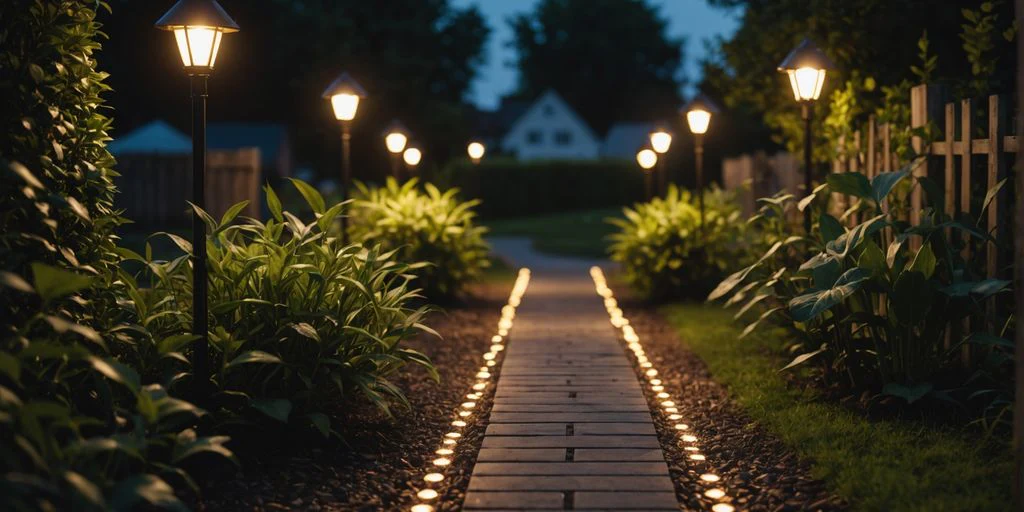Enhancing your Landscape lighting outdoor solar landscape lighting is an eco-friendly and cost-effective way to illuminate your outdoor space. By harnessing the sun’s energy, these lights offer a sustainable solution to brighten pathways, highlight garden features, and create a welcoming ambiance. This guide explores the benefits, features, installation tips, and maintenance practices for outdoor solar landscape lighting.
Benefits of Solar-Powered Landscape Lighting

Energy Efficiency and Cost Savings
Solar landscape lights operate by converting sunlight into electricity, reducing reliance on traditional power sources and lowering electricity bills. Once installed, they incur minimal operational costs, as they draw energy directly from the sun.
Environmental Impact
Utilizing solar energy decreases your carbon footprint, contributing to a more sustainable environment. Solar lights produce clean energy without emitting greenhouse gases, aligning with eco-friendly practices.
Ease of Installation and Maintenance
Solar lights are typically wireless, making them easy to install without the need for professional assistance. They require minimal maintenance, with occasional cleaning of solar panels and battery checks to ensure optimal performance.
Key Features of Waterproof Solar Lights for Gardens
Durability and Weather Resistance
Waterproof solar lights are designed to withstand various weather conditions, ensuring longevity and consistent performance. High-quality materials and proper sealing protect the internal components from moisture and debris.
Design and Aesthetic Appeal
Available in various styles and designs, solar lights can complement different garden themes and enhance the visual appeal of your outdoor space. From decorative lanterns to sleek pathway markers, there’s a design to suit every preference.
Performance and Illumination Quality
Advances in LED technology have improved the brightness and efficiency of solar lights. High-quality models offer sufficient illumination for safety and aesthetics, with some providing adjustable brightness settings.
Installation Tips for Optimal Results
Assessing Your Garden’s Layout
Identify key areas that would benefit from lighting, such as pathways, garden beds, and seating areas. Consider both functional and aesthetic purposes when planning the placement of your lights.
Ensuring Maximum Sunlight Exposure
Position solar panels in locations that receive ample sunlight throughout the day. Avoid placing lights near tall plants, walls, or other structures that may cast shadows and reduce charging efficiency.
Spacing and Placement Techniques
Space lights evenly to achieve uniform illumination and avoid dark spots. Use them to highlight specific garden features or to delineate pathways, creating a safe and inviting environment.
Maintenance and Care for Longevity

Regular Cleaning Practices
Keep solar panels clean by wiping them with a damp cloth to remove dust and debris. This ensures maximum sunlight absorption and efficient charging.
Battery Management
Monitor battery performance and replace them as needed, typically every 1-2 years, to maintain optimal functionality. Using manufacturer-recommended batteries can enhance the lifespan of your lights.
Seasonal Considerations
In regions with harsh winters, consider storing solar lights indoors to protect them from extreme weather conditions. Alternatively, ensure they are rated for winter use and can withstand lower temperatures.
FAQs about Landscape lighting outdoor solar
1. How do solar landscape lights operate?
Solar landscape lights function by capturing sunlight through photovoltaic panels, converting it into electrical energy stored in rechargeable batteries. As daylight diminishes, sensors activate the lights to provide illumination during nighttime.
2. Is direct sunlight necessary for charging solar lights?
While direct sunlight ensures optimal charging, solar lights can still accumulate energy on cloudy days or in partially shaded areas, though the charging efficiency may be reduced.
3. What duration of illumination can be expected from solar landscape lights?
Typically, fully charged solar landscape lights can illuminate for approximately 8 to 12 hours. Factors such as battery capacity, panel efficiency, and daily sunlight exposure can influence this duration.
4. Are solar landscape lights designed to be weather-resistant?
Yes, many solar landscape lights are constructed to withstand various weather conditions. However, it’s advisable to check the product specifications to confirm their durability and suitability for outdoor use.
5. Can the batteries in solar lights be replaced?
Yes, most solar lights are equipped with replaceable rechargeable batteries. Over time, battery performance may decline, and replacing them can restore the light’s efficiency.
6. Will solar lights function effectively during winter months?
Solar lights can operate in winter, but their performance may be impacted by shorter daylight hours and less intense sunlight. Ensuring the solar panels are free from snow and positioned to maximize sun exposure can help maintain functionality.
7. Do solar lights activate automatically?
Yes, most solar lights are equipped with sensors that detect ambient light levels, enabling them to turn on at dusk and off at dawn automatically.
8. How should solar lights be positioned for optimal performance?
For best results, place solar lights in locations where the panels receive direct sunlight for several hours daily. Avoid areas shaded by trees, buildings, or other structures to ensure efficient charging.
9. Are solar landscape lights as bright as wired lighting options?
While advancements have improved their brightness, solar lights may not be as luminous as traditional wired options. However, they provide sufficient illumination for pathways, garden features, and ambient lighting.
10. Is professional installation required for solar landscape lights?
No, solar landscape lights are generally designed for straightforward DIY installation, eliminating the need for wiring or professional assistance.
Conclusion
Incorporating solar-powered landscape lighting into your garden offers numerous benefits, including energy efficiency, environmental friendliness, and aesthetic enhancement. By selecting high-quality, waterproof designs and following proper installation and maintenance practices, you can create a beautifully illuminated outdoor space that is both inviting and sustainable.
For expert assistance in designing and installing solar-powered landscape lighting, consider reaching out to Ocean Landscapes, known for their innovative and sustainable garden designs. Their team specializes in creating beautiful and functional outdoor spaces that you will love.
